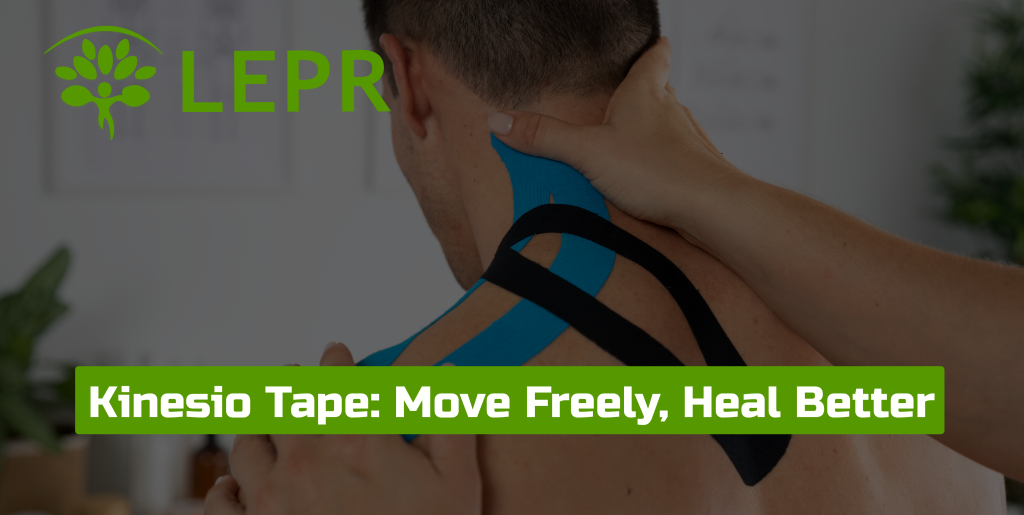
When you turn on the television and see sports stars, or when you have been to the physiotherapist, you have most likely seen some colored strips of tape around shoulders, knees, or backs. That is kinesio tape – an elastic therapeutic taping that supports and does not restrict movement in muscles and joints. Kinesio tape was originally invented by Dr. Kenzo Kase in the 1970s, but it has become popular among athletes, fitness enthusiasts, and those recovering from injury. But what is it that the Kinesio tape is doing, and what can you do with it? Here, we will discuss the advantages, applications, and methods of Kinesio tape.
What is Kinesio Tape?
Kinesio taping is medical-grade acrylic tape that is breathable and made of stretchy cotton. It also resembles the elasticity of the skin; therefore, unlike tough athletic tape, it can be moved in any direction. It is waterproof and can last several days, even during workouts, swimming, or showers.
Benefits of Kinesio Tape
Kinesio taping has numerous advantages for athletes, patients, and anyone with muscle or joint aches:
Pain Relief
- Calms the skin pain receptors.
- They are frequently used in pains of knee, back, and shoulder injuries.
Improved Circulation
- Assist in decongestion and inflammation through lymphatic drainage.
Enhanced Muscle Support
- Helps weak or injured muscles with the light support and does not limit movement.
Better Joint Stability
- Helps support the joints, such as the ankle, knees, and wrists, during sports or healing.
Faster Recovery
- Helps diminish muscle exhaustion and accelerate recovery from an injury or exercise.
Common Uses of Kinesio Tape
Kinesio tape would fit in a variety of cases, including:
- Sports Injuries: Weakness of the muscles, strains, or sprains.
- Posture Correction: It is applied to the back or shoulders to correct the position.
- Chronic Pain: It can be applied to such conditions as arthritis or tendonitis.
- Pregnancy Support: Gives lower back/ belly pain relief.
- Swelling and Bruising: Assists in healing faster through the enhancement of circulation.
How to Apply Kinesio Tape?
Kinesio taping is an important tool that should be properly applied. Here are some general steps:
Clean and Dry the Skin
Lotions, oils, or sweat can be removed to ensure better adhesion.
Cut and Round the Edges
Cut the tape to size and round the corners in order to stop peeling.
Apply with Proper Stretch
The common applications are 10-50% stretch; do not overstretch.
Rub to Activate Adhesive
When it has been applied, rub the tape softly to heat the adhesive.
Hint: When it comes to particular injuries, e.g., knee pain or shoulder support, refer to a physiotherapist or use professional taping patterns.
Safety and Precautions
Although kinesio tape is relatively safe, the following precautions must be considered:
- Should not be used on open wounds or fractured skin.
- Discontinue on the appearance of skin irritation.
- It should be used by pregnant women and individuals who have circulation problems to consult a doctor.
- Religiously consult medical advice on conditions.
Conclusion
Kinesio tape is not just a colored aesthetic tape; it is an effective method of pain treatment, muscle support, joint stability, and accelerated healing. Kinesio tape can be a good addition to your wellness routine, whether you are an athlete who needs to get some additional help, you are recovering due to an injury, or you are just a person with some aches you have to deal with on a daily basis.
This is not your first time using kinesio taping; this is why you should seek professional assistance and get to know how to do it best at first. It can also make you feel free, get better, and achieve your best when used correctly. Book a consultation at LEPR now.
Frequently Asked Questions
Yes, it prevents pain, helps to support muscles, and aids in a better recovery in a properly use.
Generally, 3-5 days, even during exercises or bathing.
Yes, it is usually applied to relieve knee pain that comes as a result of sports or excessive use
Mostly safe; however, do not use for open wounds or skin irritation.
Yes, but in case of injuries, professional guidance is advisable.




